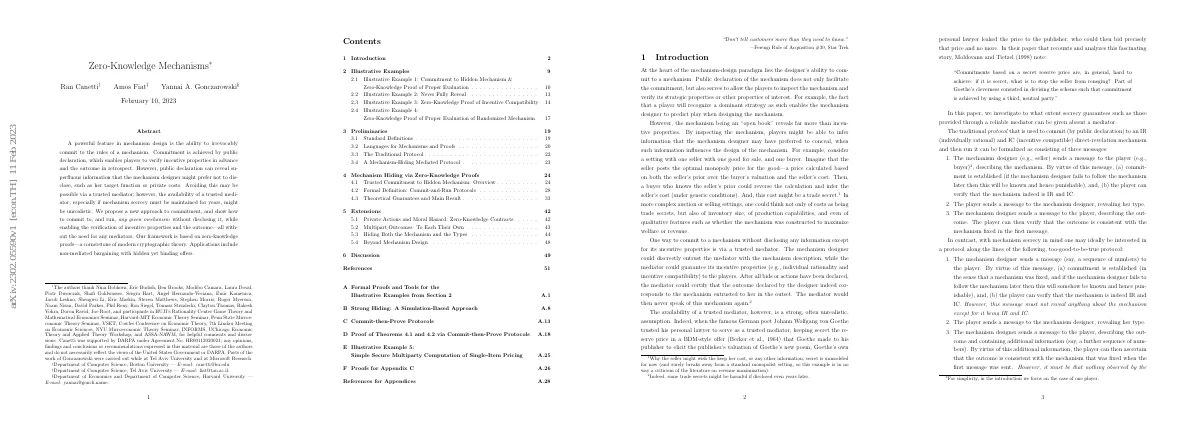Link to paper
The full paper is available here.
You can also find the paper on PapersWithCode here.
Abstract
- Mechanism design allows for commitment to rules of a mechanism
- Commitment is achieved through public declaration
- Public declaration can reveal information the mechanism designer would prefer to keep private
- A new approach to commitment is proposed that does not require a mediator
- Framework is based on zero-knowledge proofs
- Applications include non-mediated bargaining with hidden offers
Paper Content
Introduction
- Mechanism-design paradigm relies on designer’s ability to commit to a mechanism
- Mechanism must be public to allow players to inspect and verify properties
- Players can infer information from mechanism that designer may not want revealed
- Trusted mediator can guarantee incentive properties and keep mechanism secret
- Goethe’s lawyer leaked reserve price to publisher
- Protocol with three messages to commit to mechanism and run it
- Too-good-to-be-true protocol with cryptographic approach
- Cryptographic commitment to mechanism and zero-knowledge proof of incentive properties
- Player can verify outcome is consistent with mechanism
- Mechanism never disclosed to anyone
- Self-policing commitment to never-observed mechanism
- Hiding and committing guarantees under certain conditions
- Examples to demonstrate protocol and what can be deduced from outcome
- Novel simple zero-knowledge proof techniques tailored to examples
- Protocols feasibly computable and can be implemented in practice
Illustrative examples
- Seller commits to a hidden price s
- Seller sends commitment (C1, …, C log2H) to buyer
- Buyer discloses value v
- If s ≤ v, seller discloses s and trade takes place
- If s > v, seller must prove to buyer that this is the case without disclosing any additional information about s
- Seller must prove knowledge of discrete logarithm base h of at least one of Cj (j = i ∨ (j < i ∧ vj = 0))
- Seller must do this without revealing which of the numbers she knows the discrete logarithm of
- Seller must do this with negligible probability of getting discovered
- Seller must do this with modest computational power and communication
- Procedure for proving knowledge of discrete logarithm is given in Appendix A.1
- Full details of construction and proof of properties in Appendix A
- General framework avoids interaction and proof of correct evaluation consists of single message sent by seller
Illustrative example 2: never fully reveal
- Seller offers two items to a unit-demand buyer
- Buyer has private value for each item
- Seller commits to two prices
- If item is sold, mechanism is fully revealed
- If no trade takes place, buyer learns nothing except that prices are higher than their values
- If trade takes place, buyer learns price of unsold item is high enough
- Seller commits to 2 log2H bits
- Seller has to prove price of unsold item is greater than some known value
- Interactive procedure used to prove this
Illustrative example 3:
- Simplifying feature of Illustrative Examples 1 and 2 is that every mechanism is inherently IC and IR
- Illustrative Example 3 is an auction setting with two prices, s1 and s2
- Lemma 2.1 states that the mechanism is IC if and only if s1 is less than or equal to s2
- Seller must prove that s1 is less than or equal to s2 and what s1 + s2 is without revealing any additional information
- Seller commits to each bit of s1 and s2 and uses a new extension of the procedure to prove the statement
- Seller must prove that the outcome is the result of the committed mechanism
- Illustrative Example 4 is an auction setting with a hidden price s
- Seller must prove that the payment is the result of a fair draw
- Seller draws a random number x and sends a commitment to x and 1-x
- Buyer draws a random number y and sends it to the seller
- Seller calculates z = x + y mod 2 and has buyer pay H if z < s and 0 otherwise
- Seller must prove to buyer whether or not z < s
